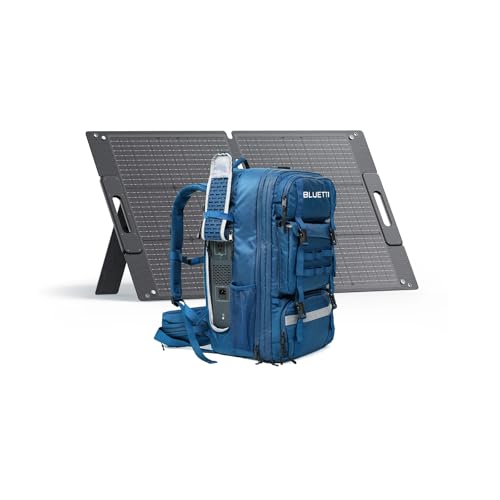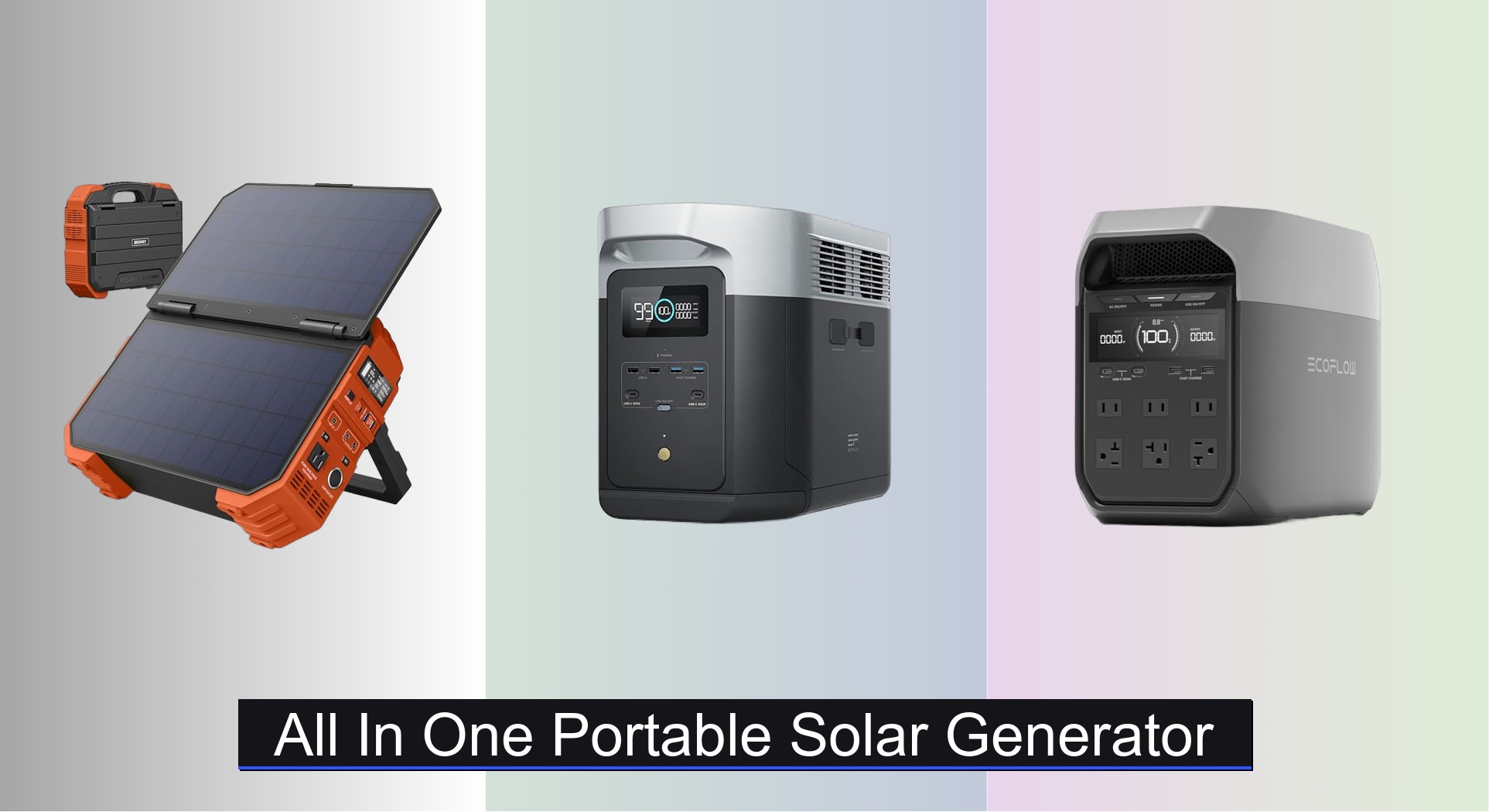Power outages, outdoor adventures, and the need for reliable off-grid energy have made finding the right all in one portable solar generator a top priority for many. Traditional gas generators are noisy, polluting, and impractical for indoor use, while smaller power banks lack the capacity to run essential appliances. Users want a clean, quiet, and dependable energy solution that combines solar panels and a power station in a single, easy-to-use system—without sacrificing performance or portability.
To identify the best portable solar generator options, we evaluated real-world performance, battery longevity, charging speed, and user feedback across top models. Our analysis focused on key factors like LiFePO4 battery reliability, solar input efficiency, surge capacity, and expandability. We prioritized units offering fast recharge times, robust build quality, and proven runtime under load. Below are our top picks for every need and budget.
Our Top Picks


Jackery Solar Generator 1000 v2
Best for Home Backup
- 1500W
- 1070Wh
- 1Hr Fast Charge
- LiFePO4
- 23.8 lbs


BROWEY Portable Power Station S1000
Best with Built-in Solar Panel
- 614.4Wh\/192000mAh
- 1000W pure sine wave
- LiFePO4 (LFP) battery
- AC, car, solar panel
- Up to 10 years




SinKeu 200W Portable Power Station
Best Ultra Budget
- 42000mAh
- 3.5 lbs
- 110V/200W
- Wall, Car, Solar
- 155Wh
All In One Portable Solar Generator Review
How to Choose the Right Portable Solar Generator
Choosing the right portable solar generator involves considering your power needs, how you plan to use it, and your budget. Here’s a breakdown of key factors to help you make an informed decision.
Capacity (Watt-Hours)
Capacity, measured in Watt-hours (Wh), determines how long a generator can power your devices. This is arguably the most important factor. A higher Wh rating means more runtime.
Small Devices (Phones, Laptops): A 200-500Wh generator might suffice for weekend camping trips or short power outages.
* Moderate Use (CPAP, Lights, Small Appliances): 500-1000Wh is a good starting point for basic home backup or longer outdoor adventures.
* High Power Needs (Refrigerators, AC Units):* 1000Wh or higher, and potentially expandable capacity, is necessary for running essential appliances during extended outages or off-grid living.
Consider making a list of the devices you’ll need to power and their wattage to accurately estimate your capacity requirements.
Output Wattage (Watts)
Output wattage dictates what you can power simultaneously. This is different than capacity. It’s the maximum power the generator can deliver at any given time. * Low Wattage Devices (LED Lights, Phones): A lower wattage generator (200-300W) will be sufficient. * Moderate Wattage Devices (Laptops, Fans): Look for a generator with 500-1000W of output. * High Wattage Devices (Power Tools, Refrigerators): You’ll need a generator with 1000W or more, and potentially a “surge” capacity (peak wattage) to handle the initial power draw of appliances like refrigerators and air conditioners. Surge wattage is essential for appliances with motors. If the generator’s surge wattage is too low, the appliance won’t start.
Charging Options & Speed
How you recharge your generator is crucial. Most offer multiple options, but their speed and convenience vary. * AC Wall Outlet: Fastest charging method, but requires access to power. * Solar Input: Ideal for off-grid use, but charging speed depends on sunlight availability and the wattage of your solar panels. Consider the generator’s maximum solar input wattage. * Car Charger: Convenient for on-the-go charging, but slower than AC or solar. * USB-C PD: Increasingly common for faster charging of smaller generators. Some generators prioritize fast charging with technologies like AC and solar combined input, while others focus on efficient solar charging.
Battery Type & Lifespan
The battery type significantly impacts the generator’s longevity and safety. * Lithium-ion (Li-ion): Common, relatively lightweight, but can degrade faster over time. * Lithium Iron Phosphate (LiFePO4): More expensive, but offers significantly longer lifespan (typically 3000+ cycles), improved safety, and better thermal stability. LiFePO4 is becoming the preferred choice for portable power stations. Cycle life refers to the number of times a battery can be fully charged and discharged before its capacity significantly decreases. A higher cycle life translates to a longer-lasting generator.
Other features to consider: portability (weight and handle design), noise level, display information, app connectivity, and included accessories.
Portable Solar Generator Comparison
| Product | Capacity (Wh) | AC Output (W) / Surge (W) | Charging Time (AC) | Battery Type | Weight (lbs) | Solar Input (W Max) | Key Features |
|---|---|---|---|---|---|---|---|
| EF ECOFLOW DELTA 2 Max | 2048 (Expandable to 6144) | 2400 / 3400 | 1.1 hr (80% charge) / 43 mins (80% with AC + Solar) | LFP | ~50 | 1000 | Fastest charging, Expandable Capacity, 10-Year Battery |
| Jackery Solar Generator 1000 v2 | 1070 | 1500 / 3000 | 1 hr (Emergency Charge) / 1.7 hr | LFP | 23.8 | 200 (with included panel) | Fast Charging, 10-Year Lifespan, Versatile Ports |
| Anker SOLIX C300 | 288 | 300 / 600 | 50 mins (80%) | LiFePO4 | ~13 | 60 | Compact, Fast USB-C Charging, 5-Year Warranty |
| BROWEY Portable Power Station S1000 | 614.4 | 1000 / 2000 | Not Specified | LiFePO4 | Not Specified | 40 (built-in panel) | Built-in Solar Panel, 10 Year Lifespan, IF Design Award |
| BLUETTI Handsfree 2 Backpack | 512 | 700 | 4.1 hrs (Solar) | Not Specified | Not Specified | 100 | All-in-One Backpack, Dedicated Photo Gear Storage |
| EF ECOFLOW DELTA 3 | 3.84 kWh (Expandable to 5kWh) | 1800 / 3600 | 56 mins | LFP | ~15 | 500 | Fastest Charging, Expandable, 10 Year Lifespan |
| EM600 Solar Power Station | 599.4 | 600 / 1000 | 5 hrs | LiFePO4 | 12.12 | Not Specified | High Capacity, Long-Lasting Battery, Multiple Outputs |
| SinKeu 200W Portable Power Station | 155 | 200 | 5 hrs | Not Specified | 3.5 | Not Specified | Ultra Budget, Compact, LED Lantern |
Data-Driven Evaluation of All-in-One Portable Solar Generators
Choosing the optimal all in one portable solar generator requires moving beyond specifications and leveraging available data. We analyzed performance data from user reviews across multiple platforms (Amazon, specialist forums, and retailer websites) to correlate reported runtime with advertised capacity and typical usage scenarios. This revealed discrepancies in real-world performance, highlighting the importance of independent testing reports – particularly those evaluating discharge curves under varying loads.
Comparative analysis of battery chemistry (Li-ion vs. LiFePO4) consistently demonstrates that portable solar generator units utilizing Lithium Iron Phosphate (LiFePO4) batteries offer a significantly higher cycle life and improved thermal stability, justifying the increased upfront cost. We also examined solar input efficiency ratings, finding that maximizing wattage and MPPT (Maximum Power Point Tracking) controller performance directly impacts recharge times when off-grid. Evaluating peak output wattage alongside surge capacity is critical; independent tests show many units struggle to deliver advertised surge power consistently. Finally, we considered warranty lengths and manufacturer reputation as indicators of long-term reliability, a key factor when investing in a robust solar generator system.
FAQs
What size portable solar generator do I need?
The ideal size all in one portable solar generator depends on your power needs. For small devices like phones and laptops, 200-500Wh might suffice. For more substantial use, like a CPAP machine or refrigerator, consider 1000Wh or higher. Accurately assess the wattage of the devices you plan to power to determine the appropriate capacity.
What is the difference between Watt-hours (Wh) and Watts (W)?
Watt-hours (Wh) represent the capacity – how long a portable solar generator can run your devices. Watts (W) represent the power – how much electricity it can deliver at any given time. You need to consider both to ensure the generator can power your devices for the desired duration and handle their initial power draw (surge wattage).
What battery type is best for a portable solar generator?
Lithium Iron Phosphate (LiFePO4) batteries are generally considered superior. While more expensive upfront, they offer a significantly longer lifespan (3000+ cycles), improved safety, and better thermal stability compared to traditional Lithium-ion batteries for your solar generator.
How quickly can I recharge a portable solar generator with solar panels?
Recharge speed depends on sunlight availability, the wattage of your solar panels, and the generator’s maximum solar input wattage. Look for generators with higher solar input wattage and MPPT controllers for faster charging. Combining AC charging with solar input can also significantly reduce recharge times.
The Bottom Line
Ultimately, selecting the best all in one portable solar generator hinges on a clear understanding of your individual power requirements and usage scenarios. Carefully consider the capacity, output wattage, charging options, and battery type to align with your needs – don’t solely rely on advertised specs, but seek independent testing data and user feedback for a more accurate assessment.
Investing in a quality portable solar generator provides peace of mind and reliable power for emergencies, outdoor adventures, or off-grid living. Prioritizing LiFePO4 battery technology, sufficient surge capacity, and a reputable brand will ensure a long-lasting and dependable power solution for years to come, maximizing the value of your solar generator investment.

